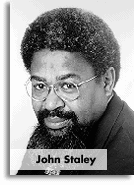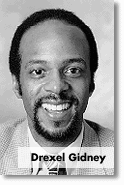 "With this grant, we are trying to change the
face of science," said
John Staley, headmaster of Cora P. Maloney College at UB, and
principal investigator on the grant.
"With this grant, we are trying to change the
face of science," said
John Staley, headmaster of Cora P. Maloney College at UB, and
principal investigator on the grant. 
Under the State University of New York (SUNY) Alliance for Minority Participation, a new five-year, $5 million program, UB is expected to receive a total of $1 million. The university has received $200,000 in funding for the first year.
By the end of the five years, UB expects to see an increase in the number of minority undergraduates in these areas, as well as in the number of minority students who go on to graduate school in these fields.
The idea behind the SUNY Alliance is to provide and strengthen alliances between programs for minority students that already exist at SUNY institutions so that more students can be accommodated.
 "With this grant, we are trying to change the
face of science," said
John Staley, headmaster of Cora P. Maloney College at UB, and
principal investigator on the grant.
"With this grant, we are trying to change the
face of science," said
John Staley, headmaster of Cora P. Maloney College at UB, and
principal investigator on the grant.
He noted that a recent report by the U.S. Department of Education showed that out of a total of nearly 78,000 bachelor's degrees awarded in engineering in 1993, 3,700 were earned by African-Americans and 2,900 by Hispanics.
A report in Science magazine stated that in the U.S., minorities earn a "tiny" proportion of science and engineering Ph.D.s, only 5.9 percent of those conferred in 1992.
Statistics at UB reflect this national trend, according to Staley. On the undergraduate level, UB's School of Engineering and Applied Sciences graduates about 20 minority students each year, out of a typical class of about 400 students. A handful of minorities graduate each year with degrees in mathematics. Statistics are similar at the other SUNY institutions and across the U.S., Staley said.
 Drexel Gidney, director of engineering
minority programs at UB and co-investigator on the grant, noted that
many activities providing academic and pre-professional support to
minorities already exist at UB. He cited C-STEP (College Science and
Technology Enrichment Program), the Ronald E. McNair Postbaccalaureate
Achievement Program, and active student chapters of national societies,
such as the National Society of Black Engineers and the Society of
Hispanic Engineers.
Drexel Gidney, director of engineering
minority programs at UB and co-investigator on the grant, noted that
many activities providing academic and pre-professional support to
minorities already exist at UB. He cited C-STEP (College Science and
Technology Enrichment Program), the Ronald E. McNair Postbaccalaureate
Achievement Program, and active student chapters of national societies,
such as the National Society of Black Engineers and the Society of
Hispanic Engineers.
"UB has a rich array of programs for minorities, but in order to be truly effective, these programs need additional support," he added, citing the decline in state funding that the programs have seen in recent years. "The goal of this grant is to serve as a catalyst in linking all of these programs so that we can expand the numbers of students we serve."
Minority programs throughout SUNY have seen recent declines in state funding, Staley noted. "By making stronger connections between programs that already exist," he added, "this grant allows us to leverage the opportunities available for minorities at UB."
The SUNY Alliance for Minority Participation will focus on two areas. The first is academic support services, such as specialized tutoring in engineering, math and science. It also will include the formation of study groups, where students collaborate and learn from one another. "At UB, we have found that the most successful students are those who study with other students," said Staley.
The second area of focus is enrichment of the academic experience through placement in internships in campus-based research projects or at local technology companies.
As part of the grant, UB also will host an annual statewide conference of graduate and professional schools geared toward minority students throughout SUNY. The 1997 conference will be held in April.
In addition to increasing the number of minority students at the undergraduate level in science, mathematics, engineering and technology, the SUNY Alliance is expected to increase their representation at the graduate level by enlarging the pipeline of minority undergraduates in these areas.
In addition to UB, the university centers at Binghamton and Stony Brook, and the State University College at New Paltz are the other lead institutions in the state. Each will work with a four-year and/or community college in its region to strengthen programs for minorities in the physical sciences, mathematics and technology. UB will work with the State University College at Buffalo.
A regional board of advisors, with members from the academic and business communities, is being formed.